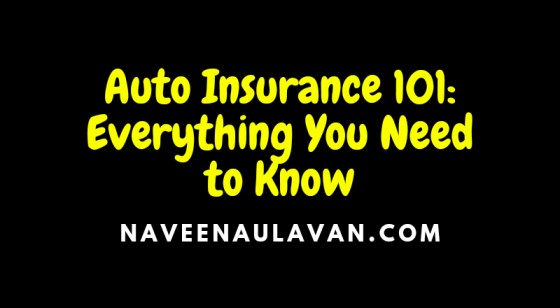Auto insurance is a vital component of owning a vehicle. It provides financial protection in case of accidents, theft, or other unforeseen events. Understanding the basics of auto insurance is essential for every driver. In this comprehensive guide, we will cover everything you need to know about auto insurance, including its types, coverage options, factors affecting premiums, and tips for finding the right policy.
What is Auto Insurance?
Auto insurance is a contract between an individual and an insurance company, where the individual pays a premium in exchange for coverage against potential damages or losses related to their vehicle. It acts as a safety net that helps protect drivers, passengers, and their vehicles in case of accidents, theft, vandalism, or other covered incidents.
Types of Auto Insurance
Liability Insurance
Liability insurance is the most basic and essential type of auto insurance. It covers damages or injuries caused by the policyholder to other people or their property in an accident. It typically includes two components.
Bodily Injury Liability
This coverage pays for medical expenses, lost wages, and legal fees associated with injuries or death caused by the policyholder.
Property Damage Liability
It covers the cost of repairing or replacing another person’s property that was damaged in an accident caused by the policyholder.
Collision Insurance
Collision insurance provides coverage for damages to the policyholder’s vehicle caused by a collision with another vehicle or object, regardless of fault. It helps repair or replace the damaged vehicle, up to the policy’s coverage limit, minus the deductible.
Comprehensive Insurance
Comprehensive insurance protects against non-collision incidents, such as theft, vandalism, fire, natural disasters, or hitting an animal. It covers the cost of repairing or replacing the vehicle, subject to the policy’s limits and deductible.
Personal Injury Protection (PIP) Insurance
Personal Injury Protection, also known as “no-fault” insurance, covers medical expenses, lost wages, and other related costs for the policyholder and passengers injured in an accident, regardless of fault. PIP insurance is mandatory in some states.
Uninsured/Underinsured Motorist Insurance
Uninsured/Underinsured Motorist (UM/UIM) insurance protects the policyholder if they are involved in an accident with a driver who has no insurance or insufficient coverage. It helps cover medical expenses, lost wages, and other damages.
Factors Affecting Auto Insurance Premiums
Auto insurance premiums are determined by various factors that insurers use to assess the risk associated with insuring a driver. Some common factors include:
Age and Gender
Younger drivers, particularly teenagers, tend to have higher premiums due to their lack of driving experience. Statistically, male drivers also have higher accident rates, leading to higher premiums.
Driving Record
A clean driving record with no accidents or traffic violations can lower your premiums, while a history of accidents or tickets may increase them.
Vehicle Type
The make, model, age, and safety features of your vehicle can impact your insurance rates. Expensive or high-performance cars usually have higher premiums.
Location
The area where you live affects your premiums. Urban areas with higher traffic congestion and crime rates tend to have higher insurance costs.
Coverage and Deductibles
The type and amount of coverage you choose, as well as the deductible (the amount you pay out of pocket before insurance kicks in), can impact your premiums.
Credit Score
In some states or countries, insurers may consider your credit score when determining your premiums. A higher credit score can result in lower insurance rates.
Tips for Finding the Right Auto Insurance Policy
Shop Around
Obtain quotes from multiple insurers to compare prices and coverage options. Different insurance companies may offer varying rates and discounts, so it’s important to do your research and gather multiple quotes.
Assess Your Coverage Needs
Evaluate your specific needs and determine the level of coverage required. Consider factors such as your driving habits, the value of your vehicle, and your financial situation. This will help you choose the appropriate coverage types and limits.
Understand Deductibles
Deductibles are the amount you agree to pay out of pocket before your insurance coverage kicks in. Higher deductibles typically result in lower premiums but make sure you can comfortably afford the deductible amount in case of an accident.
Look for Discounts
Insurance companies offer various discounts that can help lower your premiums. Common discounts include safe driver discounts, good student discounts, bundled policies, and discounts for safety features in your vehicle. Inquire about available discounts and take advantage of them.
Review the Policy Terms and Conditions
Carefully read and understand the terms and conditions of the policy before making a final decision. Pay attention to the coverage limits, exclusions, and any additional fees or charges. Clarify any doubts or questions you may have with the insurance provider.
Consider Customer Service and Reputation
Look for an insurance company with a solid reputation for customer service. Read reviews, check ratings, and seek recommendations from friends or family. Good customer service can make a significant difference when filing claims or dealing with policy-related matters.
Evaluate Financial Stability
Verify the financial stability and strength of the insurance company. A financially stable company ensures that it can fulfill its obligations in the event of a claim. You can check the financial ratings of insurance companies through rating agencies like A.M. Best or Standard & Poor’s.
Review and Update Your Policy Annually
As your circumstances change, such as getting married, moving, or buying a new vehicle, review your policy annually to ensure it still meets your needs. Update your coverage and inform your insurer of any changes to avoid any potential gaps in coverage.
Conclusion
Auto insurance is a crucial aspect of responsible vehicle ownership. It protects you, your passengers, and your assets in case of accidents or unforeseen events. By understanding the types of coverage, factors affecting premiums, and tips for finding the right policy, you can make informed decisions when choosing auto insurance. Remember to assess your needs, compare quotes, and consider the reputation and customer service of insurance companies. With the right coverage in place, you can drive with confidence knowing you are protected.
